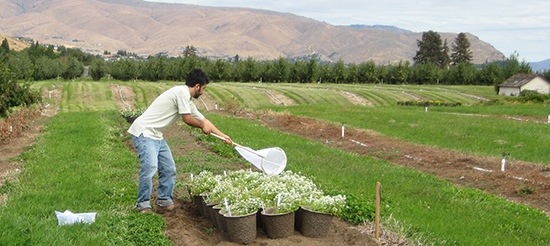A simple and effective way to control aphids — often one of the most significant pests in fruit orchards — has been developed by researchers at Washington State University. All it takes to control the aphid population…. are flowers.
The researchers at WSU discovered that simply by planting sweet alyssum flowers that fruit growers can effectively control the aphid population — via increased numbers of aphid predators attracted by the flowers. The researchers think that the discovery is a boon not only for organic growers but conventional too, because of how effective it is, especially with regards to costs.
Specifically, the sweet alyssum flowers attracted a variety of spiders and other predator bugs to the orchard, all of which preyed on the woolly apple aphids found there. Wooly apple aphids are currently typically controlled with chemical sprays, the new discovery offers a significantly simpler, and more environmentally-friendly, solution.
“The results were striking,” said Lessando Gontijo, who led the research project while a doctoral student in the WSU Department of Entomology. “After one week, aphid densities were significantly lower on trees adjacent to flowers than on control plots, and these differences were maintained for several weeks.”
Before settling on the sweet alyssum flower, the researchers screened 6 total candidates, including marigolds and zinnias. Sweet alyssum was chosen because it was found to attract the most hoverflies, also known as syrphids, which produce larvae that eat aphids. Hoverflies and a large variety of other insects search out flowers, and often live near them, because of the free food provided by the flowers — pollen and nectar.
But contrary to the researchers expectations, while the sweet alyssum did significantly lower aphid numbers, it wasn’t because of the hoverfly larvae. “Researchers compared plots of apple trees with sweet alyssum to plots without flowers. While the sweet alyssum attracted hoverflies, as desired, Gontijo and colleagues found few hoverfly larvae, showing that the hoverflies had only a marginal effect on the aphid population.”
The real aphid-killers were the large numbers of spiders and other predatory insects attracted by the sweet alyssum. “But was it really the flowers that attracted aphid predators? The scientists sprayed protein markers on the sweet alyssum and later captured insects and spiders at a distance from the flower plots. Many of the insects and spiders tested positive for the proteins, proving that they had visited the flowers.”
“The woolly apple aphid is surprisingly damaging for an aphid, attacking tree shoots and roots,” stated Betsy Beers, an entomologist based at WSU’s Tree Fruit Research and Extension Center in Wenatchee and Gontijo’s mentor and a co-author of the new study. “These aphids also secrete a sticky liquid called honeydew, which can coat the apples, causing much annoyance during harvest.”
“The aphids were previously kept at bay when orchardists sprayed pesticides to control codling moths. Since the phase-out of organophosphate insecticides, though, the woolly apple aphid has been making a comeback in central Washington and elsewhere.”
According to the researchers, it is a very simple process to use sweet alyssum flowers for biological control, and it is easily integrated with other more-standard orchard-management practices.
The new research was recently detailed in the journal Biological Control.
Source: Washington State University
Image Credit: Betsy Beers, WSU; Old Apple Orchard via Wikimedia Commons




